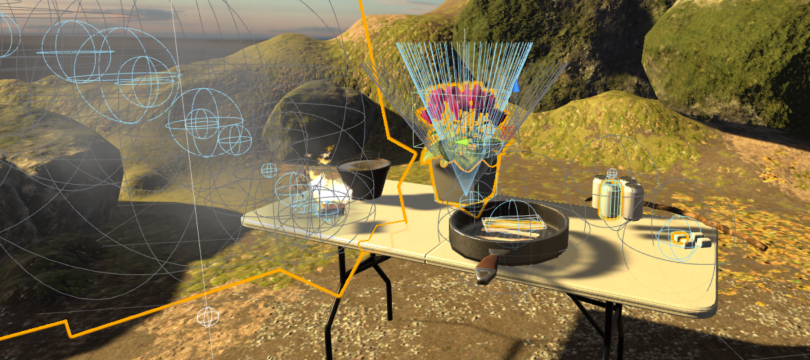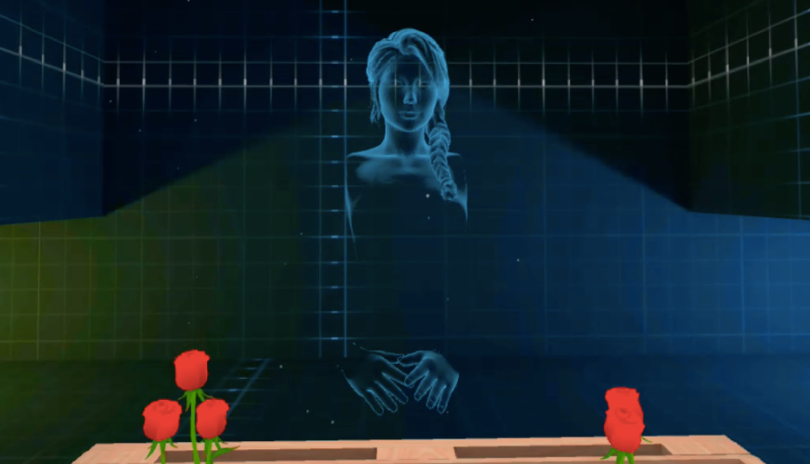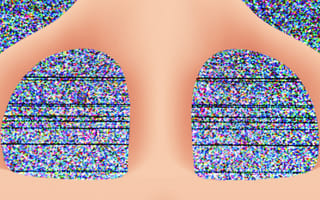The complicated, oft-mocked, yet defiantly resilient history of scent-based immersion technology is long enough to fill volumes. But if you’re looking for a microcosm of that history, the University of Chicago’s Human-Computer Integration Lab offers a pretty good option.
That’s where Ph.D. student Jas Brooks has led the development of two smell-based hardware prototypes — one that generates “virtual smells” and another that creates “temperature illusions.” Both act through the nose, by stimulating the trigeminal nerve. And both were tested and built to operate in virtual environments, representing a proof-of-concept highlight for how scent might be meaningfully incorporated into extended reality. The former technology may, in time, help assist people who have smell loss, while the latter could make it easier to create temperature sensations in virtual worlds.
Scent in Virtual Reality
The Lab also currently houses what, according to Brooks, is the last known Smell-O-Vision machine in existence. Smell-O-Vision, introduced at the 1939 World’s Fair and used in conjunction with just one commercial release (in 1960), was Swiss inventor Hans Laube’s ill-fated attempt to bring smell to cinema. The machine operated via a “smell brain” — belt-linked perfume containers that released scents in sync with a magnetic track imprinted on the celluloid.
It, on the other hand, was considered a proof-of-concept lowlight. Contemporary reviews were not impressed. Bosley Crowther, of the New York Times, wrote, “[W]hatever novel stimulation it might afford … appears to be dubious and dependent upon the noses of the individual viewers and the smell-projector’s whims.” Legacy appraisals tend to follow suit. TIME, for instance, declared Smell-O-Vision “one of the worst ideas of the [20th] century,” right up there with Prohibition and the Titanic.
Brooks disagrees. They’re in the early stages of a project to either restore the system, or document and open-source its design — or perhaps both. “It’s really a question of revisiting these things that have been dismissed largely as jokes,” they said. To that end, Brooks also runs film and video game panel discussions that spotlight neglected, scent-infused pop-culture artifacts, like Rugrats Go Wild and Leather Goddesses of Phobos.
Still, the bad reputation has stuck, and it lingers over current efforts to bring scent to emergent technology and immersive environments. Scent-tech optimists still contend that when the much-hyped metaverse truly arrives and matures, you’ll indeed be able to smell it. But whether the technology can take the leap, most notably as olfactory-enhanced VR systems, rests in part on shaking that funky baggage.

Why Do People Look Down Their Noses at Smell?
Some of that baggage may run deeper than technology or design, down to deep-rooted cultural association. “Historically, as a Western society, we’ve kind of acclimated ourselves to odors being something almost low rung, like a lowbrow modality,” Brooks said.
The reputation arguably stretches back to the ancient Greeks. In Aristotle’s hierarchy of the senses, smell sits in the mushy middle, ahead of touch and taste, but behind sight and hearing. In the early modern era, the arrival of the printing press and the rise of Enlightenment philosophy both further elevated sight and relegated smell, Jude Stewart writes in Revelations in Air: A Guidebook to Smell.
“Historically, as a Western society, we’ve kind of acclimated ourselves to odors being something almost low rung, like a lowbrow modality.”
A contemporary preoccupation with sanitizing smells down to “unscented” flatness has largely maintained the impulse, according to Stewart: “Smell’s standing among our five (or more senses) is still quite modest in the modern world.”
Much scent-based technology, beginning with Smell-O-Vision’s five-star-flop reputation, has also failed to launch. OPhone, a prototype device co-created by Harvard aerosol scientist and professor David Edwards and his design students Rachel Field and Amy Yin, allowed users to send “olfactory messages” through phones to Bluetooth-connected scent-emitting gadgets. But it fizzled out in 2017, five years after initial development. In VR, Feelreal created a scent-based headset attachment in 2019, but the project has been beleaguered by repeated delays and frustrated backers.
The very idea of incorporating smell components into audio-visual tech was considered so laughable in 2013 that, as author and augmented reality expert Helen Papagiannis noted in her book Augmented Human, Google mocked the notion with its April Fool’s prank that year: Google Nose, an “Aromabase” of scented search results.
And yet, there is reason to take the future of immersive scent-tech seriously.
Alongside advances like Brooks’, there’s mounting research that illustrates smell’s unique relationship to memory, emotion and spatial navigation. (Our olfactory bulb is connected to the limbic system, which supports these faculties.) At the same time, some scent-supporting VR has advanced to the point where it’s being tried in the real world for healthcare and training purposes, if not yet widespread consumer entertainment.

On the Scent of Better Olfactory VR Systems
Robert Stone is among the believers. A professor of extended reality and human-centered design at the University of Birmingham, Stone has been investigating scent-based virtual reality systems since 1996.
Many of the limitations he encountered over the years are essentially the same critiques that Smell-O-Vision faced in 1960. In one VR system, smells wouldn’t dissipate quickly enough and ended up clumping together. In another, a noisy fan tipped off users that a scent was incoming, breaking the spell of immersion. And most were guilty of scent-tech’s cardinal sin: The smells just weren’t that convincing.
But Stone found a “major breakthrough” when he tried a cartridge-based device that attaches to VR headsets, an offering from a company called OVR Technology. He incorporated the attachments in his 2020 Virtual Mayflower project, an attempt to immerse participants in the sights and sounds (and smells) of the Plymouth harbor from which the pilgrims set sail. Participants responded uniformly positively, Stone said, and OVR had solved those pesky problems of noisy delivery and lingering smells, he added.
His only reservation? Some scents weren’t quite as persuasive as he’d anticipated, namely the smell of the sea and — understand: Stone was really going for authenticity — the stench of excrement, “which was all over the place back in the 17th century.” (OVR co-founder Sam Wisniewski said they intentionally dialed back the extremity when sourcing the poop smell, lest participants find themselves overwhelmed. “Scent in VR is a new thing and we don’t want to turn people off instantly,” he said.)

Passing the Design Smell Test
OVR tackles the challenges of olfactory VR design through three key design factors, according to Matt Flego, the company’s chief technology officer. First, the device is literally right under your nose. “You don’t want to fill the whole room and then try to evacuate it. That’s just a ton of energy and wasted material,” said Flego. (In other words, avoid the Smell-O-Vision approach.)
Also, the scents are water-based formulations, which allow them to be quickly absorbed. And they’re released via quick-acting piezoelectric actuators, which are capable of emitting just-so amounts of aroma. “It allows [the scent] to not just be perceived, but your breath clears it the same way that it would in the real world,” said Wisniewski. (Unlike some olfactory VR devices, there’s no heating element used to release smells, which can degrade scent composition.)
Aromas are tied to “scent tags” on items or interactions within the virtual content, which communicates to the device via Bluetooth. It “then knows which scent to trigger and in which quantity,” Wisniewski explained.
Right now, OVR’s devices are available for use in modules designed by the company. They fall under two (very different) categories: training modules for dangerous industries, like defense and oil and gas, and wellness and mindfulness modules, expanding on the promise VR has already shown in pain and stress management. A plug-in system that allows developers to build scent components into their own virtual worlds through gaming architectures Unity and Unreal Engine is also available.

Challenges Ahead
All hardware design is a game of tradeoffs, and olfactory VR is no different. Upping the reservoir capacity of a cartridge, for instance, would expand the number and richness of scents available in an experience, but the added volume would make the device bulkier. It’s still too early to say where that capacity sweet spot is, but it underscores an obvious but important fact: Scents just aren’t as easily generated as video and audio.
That means cartridge swap-outs and subscription-based refills, most likely — which is how OVR’s devices operate. The setup works for healthcare and training applications, but it could complicate the consumer-entertainment adoption that scent-tech researchers hope to see.
Smell and smell intensity can also be highly subjective, as anyone who’s attended a wine tasting (or debated the pungency of poop approximations) can attest. Luckily, VR’s visual immersiveness can help guide and shape users to the intended interpretation, Flego noted. Still, if scent feeds off sight, it underscores that environment designers can’t slack on their virtual world-building.
There’s still that nagging history, too. “Truth be told, consumer skepticism is quite high, and it’s come about because of the stigma of Smell-O-Vision,” Flego said. “It comes across as a gag.” But when channeled to a six-degrees-of-freedom environment, rather than the more passive cinema experience, that doubt starts to fall away, he said. Scent technology “was just paired with the wrong medium.”
“Truth be told, consumer skepticism is quite high, and it’s come about because of the stigma of Smell-O-Vision ... It comes across as a gag.”
There’s an argument to be made that Smell-O-Vision deserves a better rep. Media and practice scholar Catherine Clepper has written that Laube and like-minded inventors held sincere desires to create multi-faceted experiences that were more than the sum of those facets. She also notes that exhibition “gimmicks” like 3D and Cinerama actually gave way to the widescreen aspect ratio — accepted practice that now carries no novelty baggage whatsoever. Could we afford Smell-O-Vision the same runway as a potential noble-but-failed precursor of success, rather than just a pop-cultural punching bag?
Hardware designers have enough challenges without being asked to upend decades of inherited narrative. Still, back in Chicago, Brooks is doing their part, honoring legacy smell-tech’s camp charm, while still taking it seriously, and helping chart its future.
Brooks is a fan of olfactory VR but also suspects the tech’s real impact may prove to be in tuning or amplifying scents in augmented reality — possibly for those who’ve suffered smell loss or dampened trigeminal nerve function — rather than recreating them wholesale in virtual worlds. “There’s something about the odors of everyday life that are already so rich,” they said.
It underscores the fact that, in some ways, the future remains unwritten for immersive scent-tech. “That’s always the issue with this kind of technology: What is the end goal?” Brooks said. “Is it transferring information? Is it producing evocative experiences for entertainment? Is it cultural archiving?” (Like Stone’s aromatic 1620 harborside?)
However things progress, adherents of scent technology and extended reality are convinced that you can’t have one without the other. “There is a huge, very stark difference between experiencing something that has scent and something that doesn’t,” Flego said. “It feels like colorless TV.”




